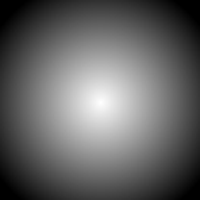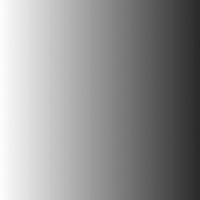Working with Paints
Paint is the general name for anything used to stroke or fill graphical entities. MandalaMaker currently supports two types of Paints: Colors and Gradients.
Colors
In the context of MandalaMaker graphics, the term color denotes a uniform color which can be used as a stroke or fill. Colors for the Line, Fill and Background can be selected from the Line & Fill Palette.
Color Spaces
We all have a sense of what we mean by color, but in fact, color is one of the more complex subjects for artists, technicians and scientists alike. Human eyes, computer screens, and printers all deal with color in different ways. In particular the way human beings respond to color is extremely subjective.
On the computer, we need to define colors in some concrete way. One of the ways we do this is through the concept of color spaces. Different color spaces vary in terms of the way colors are defined and in terms of the range of colors that can be created within those definitions.
MandalaMaker supports three different color spaces: RGB Color, Web Color, and CMYK Color. Switching between color spaces is done using commands on the Colors Menu, ready-made colors for each color space are available in the Paint Palette, and new colors can be created in any of these spaces using the Color Pickers. Following is a brief description of MandalaMaker's color space options.
RGB Color
RGB color is the way colors are handled by computer screens. RGB colors are comprised of three color elements: Red, Green, and Blue. The individual color values in RGB color range from 0 to 255.
RGB is what is known as an additive color system. In an additive system, the more of any color element that is added, the lighter the color gets. If all three colors are at zero, this creates black. If all three colors are at 255, the maximum, this makes white. If all three colors are at the same intermediate value, a shade of gray results. Full red and green with no blue makes yellow. Full green and blue with no red makes blue-green or cyan. Full red and blue with no green creates magenta. In this way a wide range of colors can be created.
RGB color is well suited to working with color on screen and it is the default color space in MandalaMaker.
Web Color
Not all computer monitors reproduce colors the same. With the advent of the World Wide Web, it became important to have a set of colors that would work more or less universally on all monitors. The Web color space is comprised of a 255 color subset of RGB color.
If you are creating images for the web, working in Web color assures that your images will appear the same wherever they go. The down side is that the 255 color palette is very limited.
CMYK Color
CMYK color is the way colors are handled in four color printing systems such as is done by most computer printers. CMYK colors are composed of four color elements: Cyan, Magenta, Yellow, and Black. Color values in CMYK color spaces are usually represented on a scale from 0.0 to 1.0 or from 0 to 100 (as is used in MandalaMaker), representing a percentage of ink coverage.
CMYK is a subtractive color system, meaning that the greater the value of a particular color element, the darker it is. Think more ink on the paper. If all the colors are at zero, no ink is applied to the paper and white (or more precisely, the paper color) is the result. All colors at full results in black. Predicting the results of various combinations of the color components in CMYK mode is more difficult than in RGB mode.
The gamut — the range of possible colors — is very different between RGB and CMYK. Many RGB colors can't be accurately printed to a CMYK device. Therefore, if printed output is your goal, you will get better results if you work in the CMYK color mode.
A Grain of Salt
As discussed above, color is a very complex phenomena and devices vary greatly in regard to color handling. MandalaMaker does not attempt to provide sophisticated color matching. The program depends on the capabilities of the Java Graphics system and your computer operating system to deal with this complexity.
Transparency ![]()
MandalaMaker 2 has support for color transparency. In addition to the color elements discussed above, colors in all color spaces have a transparency or alpha element that determines how opaque the color is. In RGB — technically it should be ARGB, since an alpha element is present — the alpha element uses the same range of values from 0 to 255, with 255 being opaque and 0 being completely transparent. In CMYK the alpha values range from 0 to 100, with 100 being opaque and 0 being transparent.
A graphic element with a partially transparent color will allow graphic elements behind them to show through. The observed color of any point will be a blending of the foreground object's color and the color of any background objects.
When creating colors using the Color Pickers, any level of transparency can be specified. Transparency of solid colors can also be adjusted using the Transparency Palette.
The consequences of using transparency in MandalaMaker images will vary depending on how you output them. Some of the program's output formats support transparency and some do not. For example, when exporting JPEG images, transparent backgrounds will become opaque white, but the effect of transparency between shapes is preserved, while exported PNG images will retain transparent backgrounds.
Gradients![]()
Gradients are Paints that blend from one color to another over a certain distance. Gradients can add richness and a more three-dimensional look to a drawing. MandalaMaker 2 supports gradients of two colors which blend either radially or linearly. Each of the two colors can have any level of transparency.
A radial gradient blends from one pure color in the center of the painted area into the second pure color at the periphery of the area.
Linear gradients can be either vertical or horizontal. A vertical gradient blends from one color at the left of the painted area to the second color at the right of the area, resulting in vertical bands of color. Horizontal gradients blend from one color at the top of the painted area to the second color are the bottom of the area, resulting in horizontal bands of color.
Gradients in MandalaMaker have a Spread attribute which determines how quickly one color blends into the other. The Spread can range from 0 to 100. Larger Spread values represent a slower transition from one color to the other. MandalaMaker automatically scales the gradient Spread to the area being painted. The Spread value appears numerically in MandalaMaker's Color Swatches.
MandalaMaker provides ready-made gradients in the Paint Palette. New gradients can be created using the Gradient Palette
 Radial Gradient |
 Vertical Gradient |
 Horizontal Gradient |
Be Aware:
In MandalaMaker we've chosen to designate gradients as horizontal and vertical based on the dimension in which the bands of color appear to run, which we find more visually intuitive.
However, a vertical gradient blends the colors horizontally (from left to right), while horizontal gradients blend colors vertically (from top to bottom).